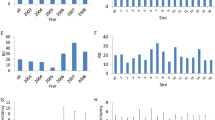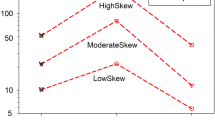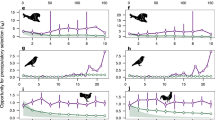Abstract
Extinction risk in natural populations depends on stochastic factors that affect individuals, and is estimated by incorporating such factors into stochastic models1,2,3,4,5,6,7,8,9. Stochasticity can be divided into four categories, which include the probabilistic nature of birth and death at the level of individuals (demographic stochasticity2), variation in population-level birth and death rates among times or locations (environmental stochasticity1,3), the sex of individuals6,8 and variation in vital rates among individuals within a population (demographic heterogeneity7,9). Mechanistic stochastic models that include all of these factors have not previously been developed to examine their combined effects on extinction risk. Here we derive a family of stochastic Ricker models using different combinations of all these stochastic factors, and show that extinction risk depends strongly on the combination of factors that contribute to stochasticity. Furthermore, we show that only with the full stochastic model can the relative importance of environmental and demographic variability, and therefore extinction risk, be correctly determined. Using the full model, we find that demographic sources of stochasticity are the prominent cause of variability in a laboratory population of Tribolium castaneum (red flour beetle), whereas using only the standard simpler models would lead to the erroneous conclusion that environmental variability dominates. Our results demonstrate that current estimates of extinction risk for natural populations could be greatly underestimated because variability has been mistakenly attributed to the environment rather than the demographic factors described here that entail much higher extinction risk for the same variability level.
This is a preview of subscription content, access via your institution
Access options
Subscribe to this journal
Receive 51 print issues and online access
$199.00 per year
only $3.90 per issue
Buy this article
- Purchase on Springer Link
- Instant access to full article PDF
Prices may be subject to local taxes which are calculated during checkout



Similar content being viewed by others
References
Athreya, K. B. & Karlin, S. On branching processes with random environments: extinction probabilities. Ann. Math. Stat. 42, 1499–1520 (1971)
May, R. M. Stability and Complexity in Model Ecosystems (Princeton Univ. Press, Princeton, 1973)
May, R. M. Stability in randomly fluctuating versus deterministic environments. Am. Nat. 107, 621–650 (1973)
Lande, R. Risks of population extinction from demographic and environmental stochasticity and random catastrophes. Am. Nat. 142, 911–927 (1993)
Ludwig, D. The distribution of population survival times. Am. Nat. 147, 506–526 (1996)
Lande, R., Engen, S. & Saether, B. E. Stochastic Population Dynamics in Ecology and Conservation (Oxford Univ. Press, Oxford, UK, 2003)
Kendall, B. E. & Fox, G. A. Unstructured individual variation and demographic stochasticity. Conserv. Biol. 17, 1170–1172 (2003)
Saether, B. E. et al. Time to extinction in relation to mating system and type of density regulation in populations with two sexes. J. Anim. Ecol. 73, 925–934 (2004)
Fox, G. A., Kendall, B. E., Fitzpatrick, J. W. & Woolfenden, G. E. Consequences of heterogeneity in survival probability in a population of Florida scrub-jays. J. Anim. Ecol. 75, 921–927 (2006)
Soulé, M. E. (ed.) Viable Populations for Conservation (Cambridge Univ. Press, Cambridge, UK, 1987)
Shaffer, M. L. Minimum population sizes for species conservation. Bioscience 31, 131–134 (1981)
Pimm, S. L., Jones, H. L. & Diamond, J. On the risk of extinction. Am. Nat. 132, 757–785 (1988)
Leigh, E. G. The average lifetime of a population in a varying environment. J. Theor. Biol. 90, 213–239 (1981)
Goodman, D. in Viable Populations for Conservation (ed. Soulé, M. E.) 11–34 (Cambridge Univ. Press, Cambridge, UK, 1987)
Morris, W. F. & Doak, D. F. Quantitative Conservation Biology: Theory and Practice of Population Viability Analysis (Sinauer Associates Inc., Sunderland, Massachusetts, 2002)
Feller, W. Die Grundlagen der Volterraschen Theorie des Kampfes ums Dasein in wahrscheinlichkeitstheoretischer Behandlung. Acta Biotheor. 5, 11–40 (1939)
Kendall, D. G. Stochastic processes and population growth. J. R. Stat. Soc. Ser. B Methodol. 11, 230–282 (1949)
Bartlett, M. S. Stochastic Population Models in Ecology and Epidemiology (Methuen, London, 1960)
Lewontin, R. C. & Cohen, D. On population growth in a randomly varying environment. Proc. Natl Acad. Sci. USA 62, 1056–1060 (1969)
Roughgarden, J. A simple model for population dynamics in stochastic environments. Am. Nat. 109, 713–736 (1975)
Tuljapurkar, S. An uncertain life: demography in random environments. Theor. Popul. Biol. 35, 227–294 (1989)
Gabriel, W. & Burger, R. Survival of small populations under demographic stochasticity. Theor. Popul. Biol. 41, 44–71 (1992)
Engen, S., Lande, R. & Saether, B. E. Demographic stochasticity and Allee effects in populations with two sexes. Ecology 84, 2378–2386 (2003)
Legendre, S., Clobert, J., Moller, A. P. & Sorci, G. Demographic stochasticity and social mating system in the process of extinction of small populations: The case of passerines introduced to New Zealand. Am. Nat. 153, 449–463 (1999)
Dennis, B., Desharnais, R. A., Cushing, J. M., Henson, S. M. & Costantino, R. F. Estimating chaos and complex dynamics in an insect population. Ecol. Monogr. 71, 277–303 (2001)
Ricker, W. E. Stock and recruitment. J. Fish. Res. Bd Can. 11, 559–623 (1954)
Drake, J. M. Density-dependent demographic variation determines extinction rate of experimental populations. PLoS Biol. 3, e222 (2005)
Burnham, K. P. & Anderson, D. R. Model Selection and Multimodel Inference: A Practical Information-Theoretic Approach (Springer, New York, 2002)
Costantino, R. F. & Desharnais, R. A. Population Dynamics and the Tribolium Model: Genetics and Demography (Springer, New York, 1991)
Grimm, V. & Wissel, C. The intrinsic mean time to extinction: a unifying approach to analysing persistence and viability of populations. Oikos 105, 501–511 (2004)
Acknowledgements
We thank M. Gibson, D. Hodgkiss, C. Koenig, T. McCabe, D. Paulus, D. Smith, N. Tcheou, R. Villalobos and M. Wu for assistance. This study was funded by the National Science Foundation.
Author Contributions B.A.M. derived and analysed the models, and analysed the data. B.A.M. and A.H. conceived the study, planned and directed the experiments, and wrote the paper.
Author information
Authors and Affiliations
Corresponding author
Supplementary information
Supplementary information
This file contains Supplementary Figures 1-4, Supplementary Methods, Supplementary Table 1, Supplementary Discussion, and Supplementary Notes. The Supplementary Figures show stochastic realisations of the models (Fig. S1), the best model fitted to the Tribolium data (Fig. S2), extensions to the models (Fig. S3) , and measurement error bias (Fig. S4). The Supplementary Methods provide a detailed derivation of the stochastic Ricker models, and equations to equate the total variance for environmental stochasticity and demographic heterogeneity. Supplementary Table 1 provides pmfs for the stochastic Ricker models. The Supplementary Discussion considers extensions to the stochastic Ricker models, the robustness of the model fit, and measurement error bias. The Supplementary Notes include additional references. (PDF 1068 kb)
Rights and permissions
About this article
Cite this article
Melbourne, B., Hastings, A. Extinction risk depends strongly on factors contributing to stochasticity. Nature 454, 100–103 (2008). https://doi.org/10.1038/nature06922
Received:
Accepted:
Issue Date:
DOI: https://doi.org/10.1038/nature06922
This article is cited by
-
Temporal variability of carabid beetles as a function of geography, environment, and species
Theoretical Ecology (2024)
-
Modeling responses of Brazilian Atlantic Forest mammals assemble to climate change
Biodiversity and Conservation (2024)
-
How can population models contribute to contemporary pest management practices?
Applied Entomology and Zoology (2024)
-
Joint estimation of survival and dispersal effectively corrects the permanent emigration bias in mark-recapture analyses
Scientific Reports (2023)
-
Running Mice and Successful Theories: The Limitations of a Classical Analogy
Journal for General Philosophy of Science (2023)
Comments
By submitting a comment you agree to abide by our Terms and Community Guidelines. If you find something abusive or that does not comply with our terms or guidelines please flag it as inappropriate.



